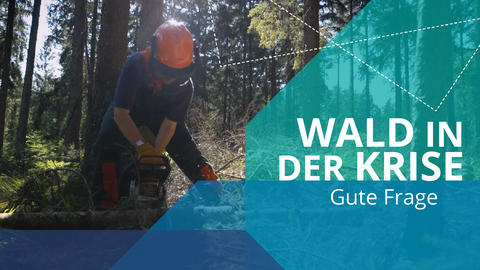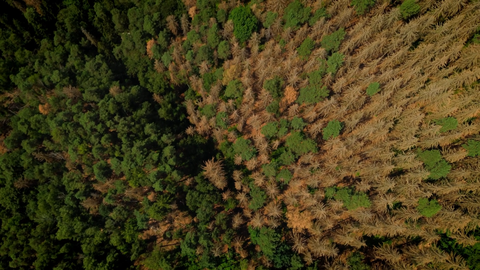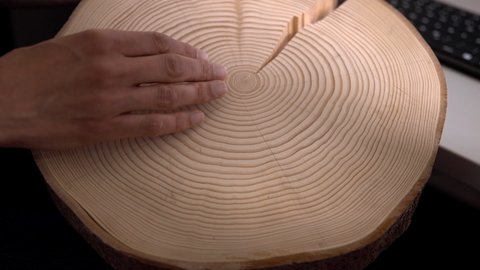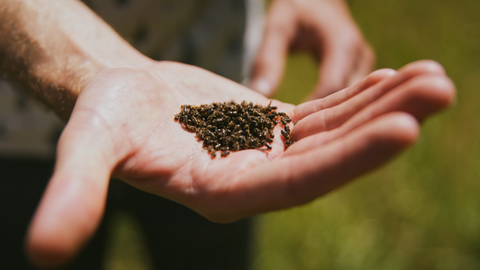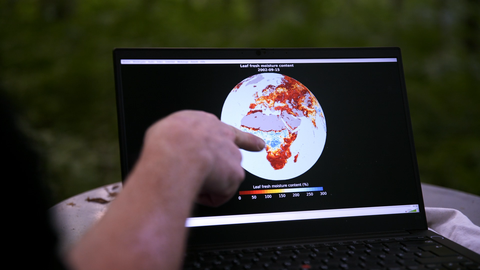Oct 03, 2023
Drought, bark beetles & forest fires: How can we make our forests fit for the future?
The drought of the last few years has left its mark on Germany's forests: Entire populations of spruce have fallen victim to the bark beetle and forest fires have caused major damage – as they did in our region's Saxon Switzerland in 2022. Researchers at TU Dresden are exploring ways to make the forest more robust for the future.
Trees generally have natural protective mechanisms against drought. “When it is dry and hot, trees can close small apertures in the leaves, their stomata, to prevent evaporation,” Professor Marieke van der Maaten-Theunissen explains. This may also result in trees having to shed leaves to ensure their survival. In addition, long-term drought can cause an increase in embolisms, which occurs when the uninterrupted flow of water between the roots and the treetop gets interrupted, causing air bubbles to form in the vessels. “If embolisms appear in a lot of places, the tree dies,” the TU Dresden forestry scientist, Professor Marieke van der Maaten-Theunissen, clarifies.
Just like his wife, Dr. Ernst van der Maaten is also conducting research at the DendroLab in Tharandt. There, researchers study the climate sensitivity of trees with the help of annual ring samples from tree slices or drill cores. “In many places in Germany, you can already see that trees are becoming much more drought-sensitive,” the head of the DendroLab says. Climate change can also be seen in the annual rings that are examined at the DendroLab. The question of how the forest will change if it becomes even drier in the future is difficult to answer, Marieke van der Maaten-Theunissen points out, “However, if pessimistic climate scenarios come true, there would be major consequences for the forest.”
The effects of drought are already becoming apparent. Spruce trees in particular have been suffering massively from the bark beetle for several years. “Animals benefit from the poor vitality of trees,” Professor Michael Müller says. “The lack of water means that the trees cannot defend themselves as well.” Healthy trees are usually able to successfully defend themselves against pests, the forest conservation expert explains. At the moment, it is particularly important to remove infested trees from the forests quickly in order to stop the beetles from spreading, he says.
By converting forests to mixed forests and using new tree species, forests should become more resistant to pests in the future. To this end, Michael Müller in Tharandt is researching not only the pests that are already known, but also those that might pose a threat in the future. Artificial intelligence (AI) could also play a role in forest monitoring in the future: A research project at the Chair of Forest Protection strives to develop a method for the early detection of insects in collaboration with partners. The aim is to develop devices that use AI to identify the odors of pests.
Monitoring also plays a significant role in identifying the risk of forest fires. Dry conditions and long periods of drought increase the risk of fires, but forest fires always require an ignition cause. “In Germany, human activities are the main source of ignition for forest fires; lightning strikes hardly ever play a role,” Junior Professor Matthias Forkel explains. The expert in environmental remote sensing wants to use satellites to predict how much risk of forest fires there is in a specific region. To this end, they measure soil and vegetation moisture.
“We want to further improve the approaches used by Germany's National Meteorological Service to report the forest fire risk index.” More detailed mapping of the vegetation can also optimize risk assessment. “Beech forests usually don't burn. Pine forests are where most of the forest fires occur in Germany,” Matthias Forkel explains. The combination of mapping forest types and weather data can contribute to a more accurate assessment of forest fire risk.
The challenges that forests struggle with as a result of climate change are also reflected in a number of books that address the issue. Dr. Solvejg Nitzke's research focuses on human-tree relationships. “There won't be the one novel or poem that finally gets everyone on board,” the literary scholar states. Nevertheless, she is convinced that the increasing amount of literature that has been published on the subject in the last few years is creating more awareness for sustainability, nature conservation and forest protection. “Trees have always been there, after all. But we're paying more attention.” Literature about forests also contributes to this fact, Solvejg Nitzke is convinced.
More on the forests of the future and solutions to current problems are addressed in the latest episode of “Gute Frage” (Good question).
© TU Dresden / aha! film
Contact:
Prof. Marieke van der Maaten-Theunissen
Chair of Forest Growth and Woody Biomass Production
Dr. Ernst van der Maaten
Head of DendroLab, Chair of Forest Growth and Woody Biomass Production
Prof. Michael Müller
Chair of Forest Protection
Jun.-Prof. Matthias Forkel
Junior Professorship in Environmental Remote Sensing
Dr. Solvejg Nitzke
Chair of Media Studies and Modern German Literature

